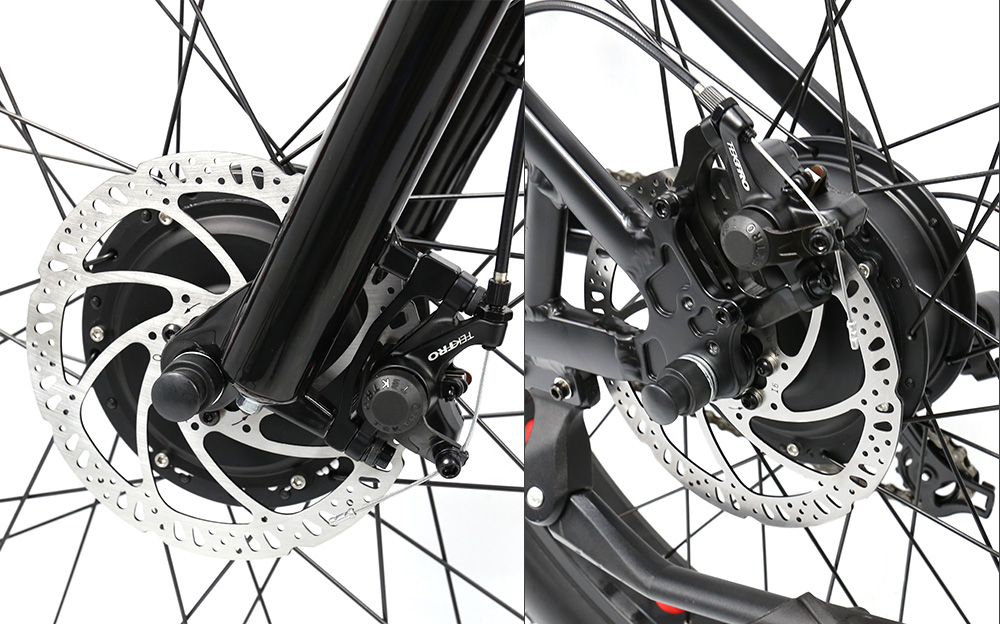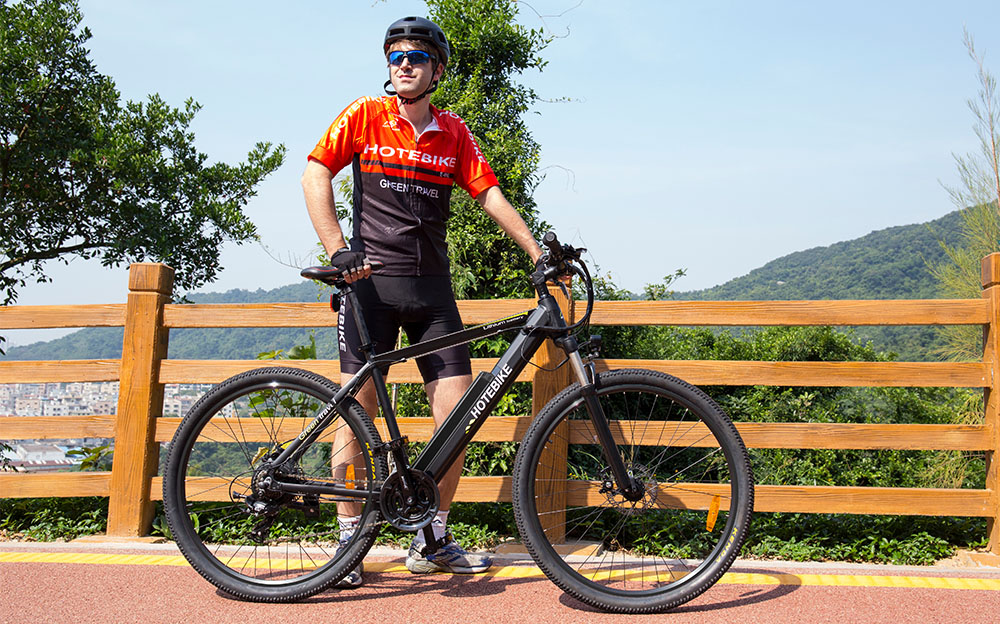WHAT DO E-BIKE MOTORS DO?
To begin with, an electric bike motor provides the rider with pedal assist. Put simply, they reduce the amount of pedal power needed to power the bicycle along. This means you can climb hills with better ease and reach higher speeds with less physical exertion. An ebike motor also helps you to sustain a speed once you reach it. Additionally, many ebikes now come with a throttling feature where you can skip the pedaling altogether by engaging the throttle.
Ebike motors can be mounted in the front, middle or rear of an ebike and, naturally, each method has its own pros and cons.
Middle mounted motors are called mid-drive motors because they sit where your pedals connect together, in the middle of the ebike, and are connected to the cranks i.e. pedals, and supply power directly to the drivetrain i.e. the chain.
Front and rear mounted motors are called hub motors because they’re mounted in the hub of the wheel (the hub is the middle of the bike wheel that surrounds the shaft which is the part that attaches the wheel to the frame. It is where one end of your spokes connects to; the other ends being connected to the wheel rim). These motors supply power directly to the wheel on which they’re mounted to; either the front or the rear.
Now you know what separates the three types of e-bike motors we’re going to discuss them, how they work, and their pros and cons.

FRONT HUB MOTORS
Front hub motors are mounted in the hub of the front wheel. These motors pull you along and effectively create a powerful all-wheel drive system for your ebike because the front tire is driven by the motor and you drive the back tire with pedals.
Pros of Front Hub Motors
Front hub motors are great in snow and on sand because of the extra traction provided by the all-wheel drive like system created by being able to power both wheels separately. To control this properly, however, requires a little bit of time to learn.
Can be used with a normal rear wheel gear setup because the motor is not a part of the drivetrain or rear wheel.
Easy to install and remove because there’s no gear system sharing the space, generally making it easier to replace a flat or to add or remove the ebike element of the bike.
If the battery is mounted in the middle or back of the bike then weight distribution can be well balanced.
Cons of Front Hub Motors
There can be the feeling that you’re getting pulled along and some people don’t like this.
There is less weight over the front wheel meaning that there is a higher tendency for it to “spin” i.e. spin loosely without gripping. This can happen on loose or steep terrain and is more noticeable on front hub motors with
more power. Riders of front hub motor bikes naturally adjust their riding style over time to compensate for this.
They are only really available in lower power options because there is far less structural support for large amounts of power around the front fork of an ebike.
Can be poor when climbing long, steep hills.
The sensors that control the pedal assist level are more of a set level style rather than the intuitive, reactive sensors that are used with other ebike motors.
Front hub motor systems are great for DIY ebikes as the requirements and parameters needed to match your current bike to a motor are very small. They do however feel very different from riding a conventional bicycle because of the pulling sensation and, if you’re looking for more power and more speed, front hub motor ebikes can struggle to lay it down properly because of the lack of weight over the front wheel. They are excellent if you’re going to be choosing to ride somewhere where it snows a lot or along a beach, as they’re able to provide you with the very necessary extra traction in these conditions.

REAR HUB MOTORS
Rear hub motors are the most common style of motor found in ebikes.These motors are housed in the hub of the rear wheel of your ebike. They give you the push feeling that we’re all familiar with and, unlike their front hub relatives, they come in a wide range of power options.
Pros of Rear Hub Motors
They are familiar: almost all bikes are powered by running power that from an electrical or combustion engine or from a human , to the rear wheels. Therefore, they closely resemble riding a traditional bike and have almost no learning curve.
With the power going through the backend, which already has weight on it, there is little to no chance of any wheel spin.
The sensors used to manage pedal assist are more intuitive, and therefore more responsive, than their front hub relatives.
There is a wide range of power options because the support that is already built into bike frames can handle it.
Excellent with the use of a throttle function to help get you off the line quickly.
Cons of Rear Hub Motors
They’re slightly more difficult to remove because the motor and the gearing are all in the same place, making changing tires a bit of a pain.
Can be back heavy if the motor and battery are both mounted on the back of the bike, which can not only make carrying them up and down stairs and loading them a bit of a problem but can also affect the handling. If the
battery is mid-mounted then this problem is significantly reduced and almost eliminated.
As said, rear hub motors are the most common type of motor found in bikes, and for good reasons. The ride is very similar to riding a traditional bike, the weight is often well balanced, and the power output can be high and power delivery is excellent. These motors can handle a lot of power because the structure is already there to support them.

HOTEBIKE A6AH26 with hidden battery
MID-DRIVE MOTORS
Mid-drive motors are mounted directly to the crankshaft i.e. the pedals, and the drivetrain i.e. the chain. These are currently the least popular technology of powering electric bicycles, but they are gaining traction. However, their limited availability does make them more expensive compared to other types.
Pros of Mid-Drive Motors
Excellent and lower center of gravity because all the additional weight can be contained in the low-middle part of the bike. This makes them easier to ride and easier to carry.You can remove both wheels with ease because neither of them are connected to the electrical element of the ebike.
The gear ratio is connected to the power source so the motor can better power you up a hill or speed you along flat ground.Because the motor and the pedals are directly connected, how hard the motor works is directly tied to how hard you push the pedals.They provide a very natural feeling of assistance because the power comes from where you apply it.
Mid-drive motors relatively often have the largest range of travel out of all ebikes motors. With the extra weight being concentrated in the middle these types of motors work great with full suspension ebikes.
Cons of Mid-Drive Motors
Heavily increased wear and tear on the drivetrain of your ebike i.e. the chain, gears, and all associated components. This means that these items need to be of a higher quality , read more expensive , and also need to be replaced more often.
Need to be shifted properly to optimize the efficiency of the motor i.e. you need to be in the right gear for the terrain you’re on at all times.Can make for a jumpy ride if it doesn’t preempt your gear shift, which many models currently don’t do.
They’re no forward gears, limiting the amount of gears you can have to solely the gears on your rear wheel.Need to change down before stopping otherwise you can’t change gear until you’ve started up again.
Can snap the chain if you’re shifting gear whilst under heavy motor power. Least common version of ebikes and for that and other reasons they’re the most expensive.It is expensive to replace the motor because it is in the bike frame, not just in the tire.
Mid-drive motor ebikes are harder to find and, when you do find one, they’re much more expensive to procure and to maintain. That being said, they have an excellent weight balance, are great up really long, steep hills and can almost always go further and faster than their hub-mounted-motor counterparts. However, learning to ride with the specific quirks of your motor when it comes to gear changing and gear management can be quite a steep learning curve.
LEAVE US A MESSAGE
 hotebike
hotebike